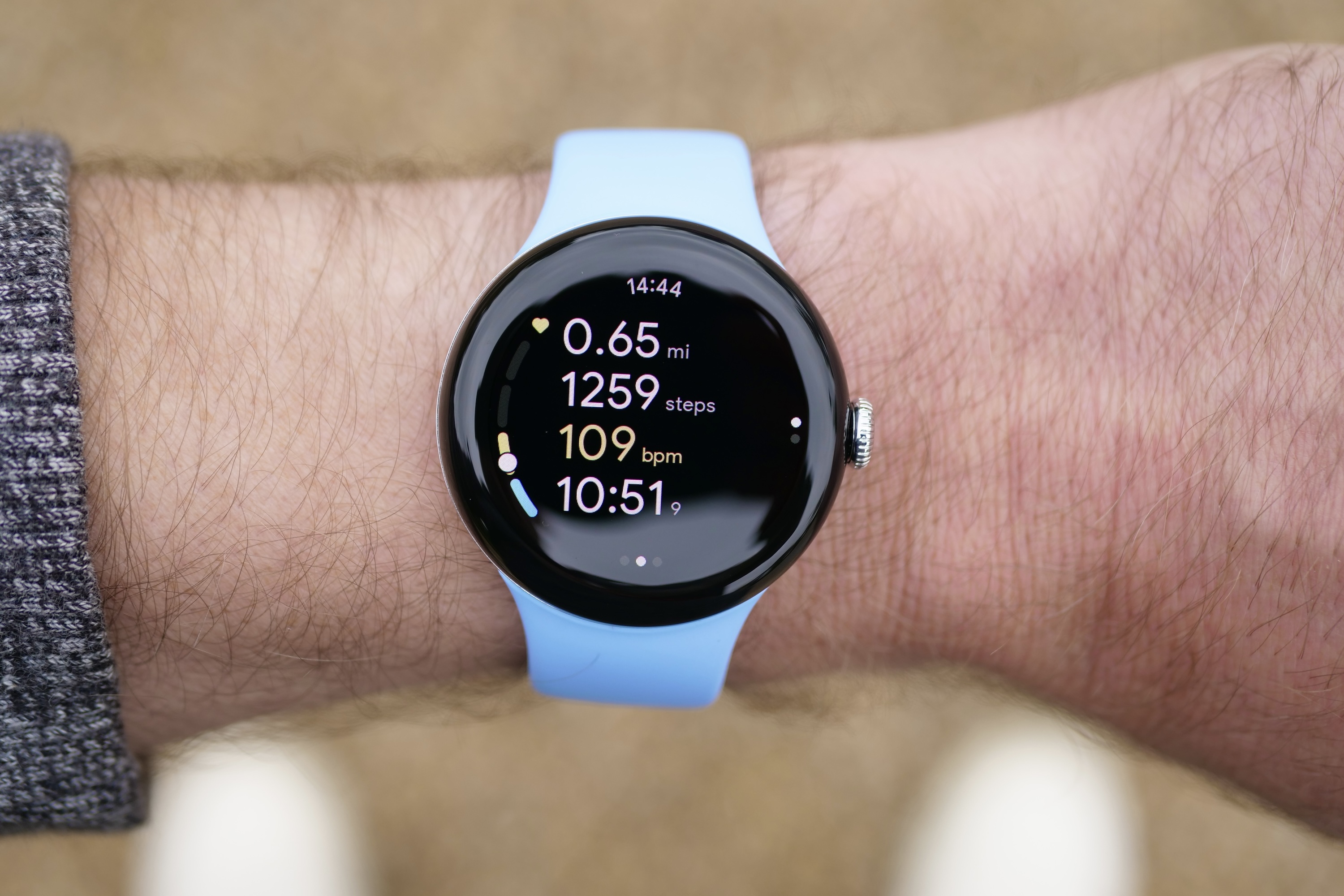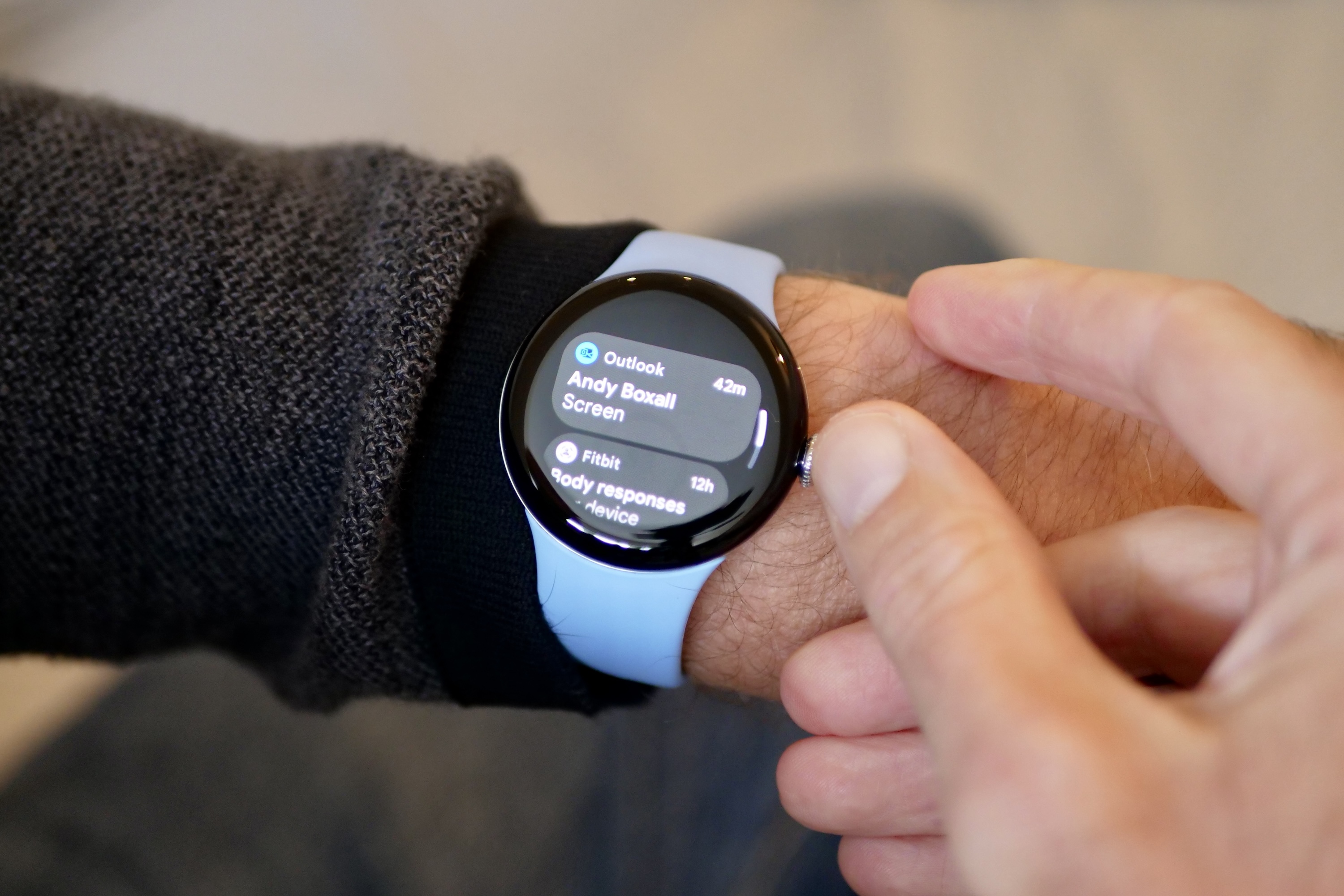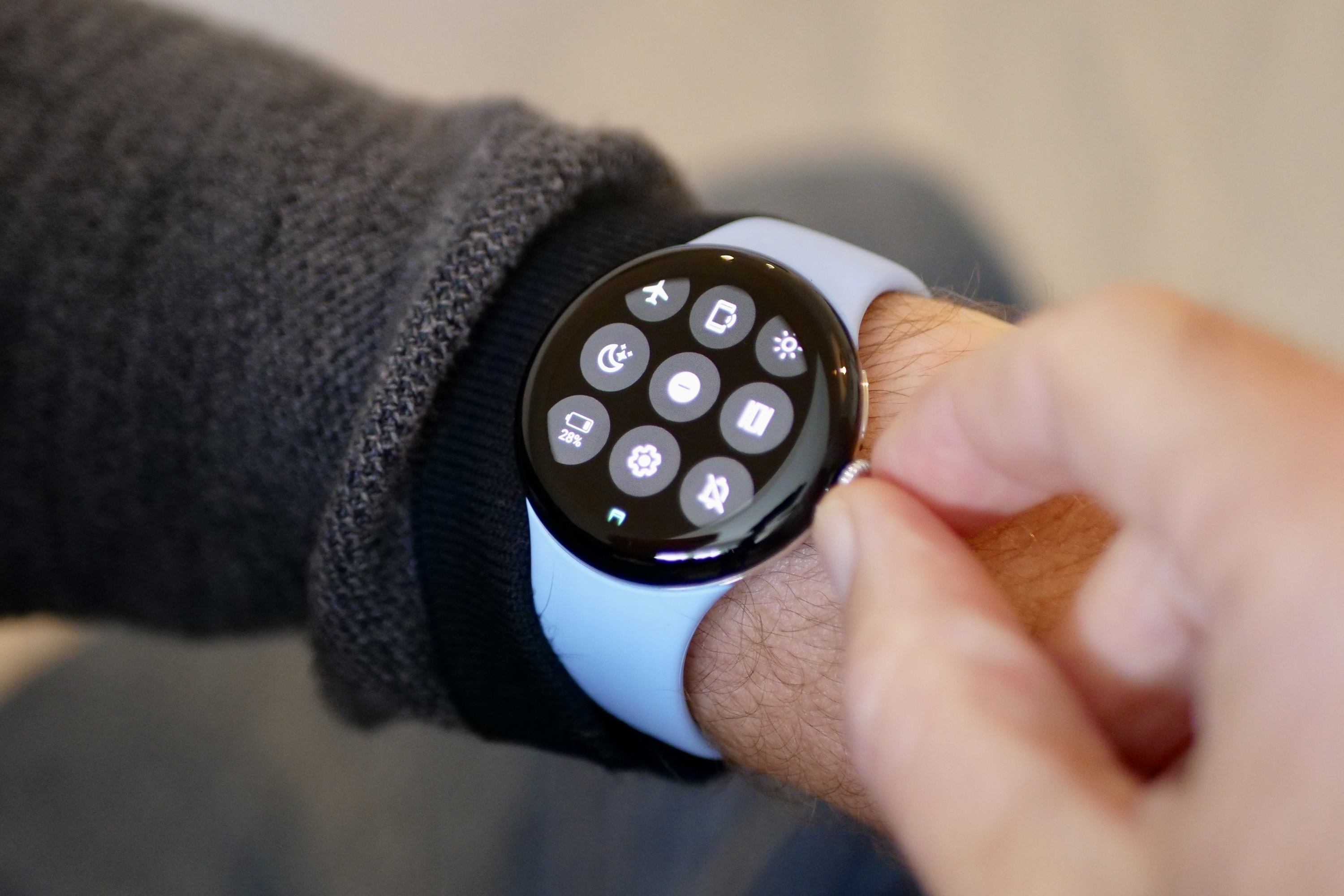- Battery lasts more than 24 hours
- One hour battery charge
- Slick, fast performance
- Comprehensive fitness tracking
- Comfortable to wear 24/7
- Only one case size
- Subscription required for all fitness data
- Small screen, big bezel
The Google Pixel Watch 2 has a difficult task ahead of it. It needs to compete with some other excellent smartwatches released this year, banish the technical issues that affected its predecessor, and change the minds of those who didn’t find the small, minimalist design appealing at all. That’s all while carrying a high price tag and having a fitness platform with a monthly subscription.
- About our Google Pixel Watch 2 review
- Google Pixel Watch 2: two months later
- Google Pixel Watch 2: design
- Google Pixel Watch 2: screen, sensors, and performance
- Google Pixel Watch 2: Fitbit
- Google Pixel Watch 2: Wear OS 4
- Google Pixel Watch 2: battery and charging
- Google Pixel Watch 2: price and availability
- Google Pixel Watch 2: verdict
That’s a lot to do, but happily, Google has stepped up to the task. At least in most cases.
About our Google Pixel Watch 2 review
Our Google Pixel Watch 2 review was initially written and published by Andy Boxall on October 16, 2023, after testing the Pixel Watch 2 for about two weeks. It was updated in early December by Joe Maring to include the “two months later” section you’ll find below.
Google Pixel Watch 2: two months later

The Google Pixel Watch 2 has now been out in the wild for just about two months, and amazingly, it still remains one of the better Android smartwatches you can buy today. Although Pixels have become notorious for degrading, with bugs and other software quirks as time goes on, the Pixel Watch 2 remains just as good today as it was at launch.
Similar to Andy’s full review below, I’ve been thoroughly impressed with the Pixel Watch 2 throughout my time wearing it. The watch’s small size, while not my favorite design choice, has grown on me more than I suspected it would; I actually think the Pixel Watch 2 can look quite good when paired with the right watch band. And small design tweaks — like the much better crown — go a long way in improving my day-to-day experience with the wearable.

The Pixel Watch 2’s battery life has also continued to impress. I regularly get through a day-and-a-half per charge with sleep tracking and the always-on display enabled. I also quite like the new charger. It feels a little cheap, sure, but it attaches securely to the Pixel Watch 2 and never gets too warm — things I can’t say about the original Pixel Watch’s charger.
What’s also impressed me with the Pixel Watch 2 is its Fitbit component. I actually feel like I can rely on the Pixel Watch 2 as a proper activity/health wearable, which is something I never thought about its predecessor. Additions like automatic workout detection and a temperature sensor make a big difference (at least for me), and the redesigned Fitbit app looks better than ever.

Similar to Andy, I didn’t go into the Pixel Watch 2 expecting all that much. Thankfully, I’ve been proven wrong about it. The Google Pixel Watch 2 remains a strong smartwatch in December 2023, and if you’re in the market for a new wearable to pair with your Android phone, it deserves a high spot on your shopping list.
Google Pixel Watch 2: design
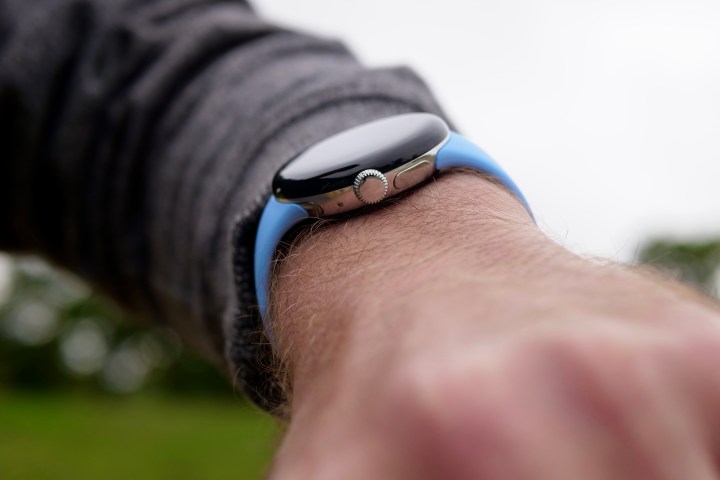
The Pixel Watch 2 looks exactly the same as the first Google Pixel Watch, which is great if you thought the first model was attractive and suitably sized for your wrist. If not, then you’re out of luck, as Google hasn’t changed its mind about making it in more than one size or improving on the stark, overly simple design.
The 41mm case is 12.3mm thick and made of recycled aluminum (different from the Pixel Watch’s stainless steel), and it weighs 58 grams with the Active band. It’s even more comfortable to wear than the first Pixel Watch, helped by the reduction in weight and the flexible new band. I have had no problem wearing it overnight to track my sleep, and it takes just moments to tighten the band before exercising. If you want to forget you’re wearing something on your wrist, the Pixel Watch 2 is ideal. The shape of the case back means the sensor always makes contact with your skin, while the curvature means it’s practically unnoticeable.
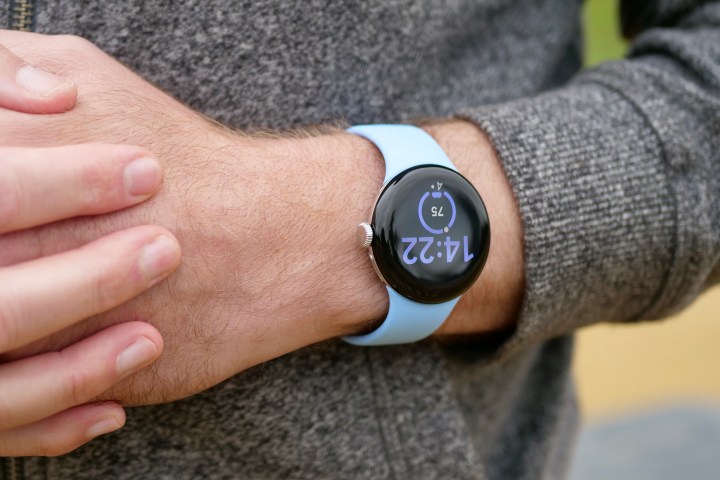
This also applies to the design. The minimalist, simple circular design lacks flair, and the single size means it will look too small on many wrists; in my opinion, it does on my 6.5-inch wrist. It also doesn’t make any kind of statement, which, like the small size, some will appreciate, but others will find off-putting.
This is supposed to be something we wear all the time, and for that, we should also connect with it on a personal, aesthetic level. The Pixel Watch 2 doesn’t succeed here at all and instead seems to be made to go unnoticed on your wrist. Because of this, in terms of design and intent, it is closer to a fitness tracker than a smartwatch.
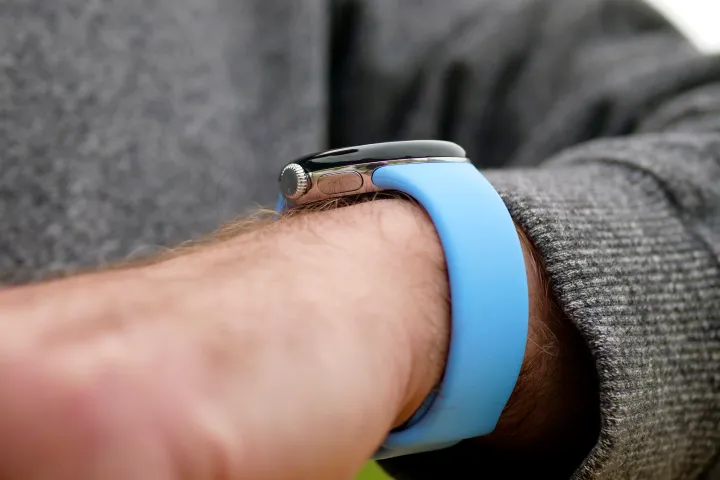
It’s also not especially high quality. The aluminum case doesn’t add much to its overall feel, it’s glass rather than sapphire over the screen, and the crown has an unpleasant clicky feel when pushed. There’s an IP68 water and dust resistance rating and 5ATM water resistance, but unfortunately, no MIL-SPEC toughness certification. It feels very ordinary, and apparently, little thought has gone into how we’re supposed to love the Pixel Watch 2. This is what separates it from other smartwatches and why it’s more closely related to faux smartwatches like the Fitbit Sense 2.
If I entirely ignore the fact it’s marketed as a smartwatch, then the Pixel Watch 2 is a superb wearable. It’s light, comfortable, durable, and entirely inoffensive on my wrist. But it is supposed to be a smartwatch, and it fails to be special or versatile enough to be an alternative to the Galaxy Watch 6 Classic, the Huawei Watch GT 4, the Tag Heuer Connected Calibre E4, or the Montblanc Summit 3. It’s also very far removed from the pure, individual, quality watch-like appeal of the Apple Watch Series 9.
Google Pixel Watch 2: screen, sensors, and performance
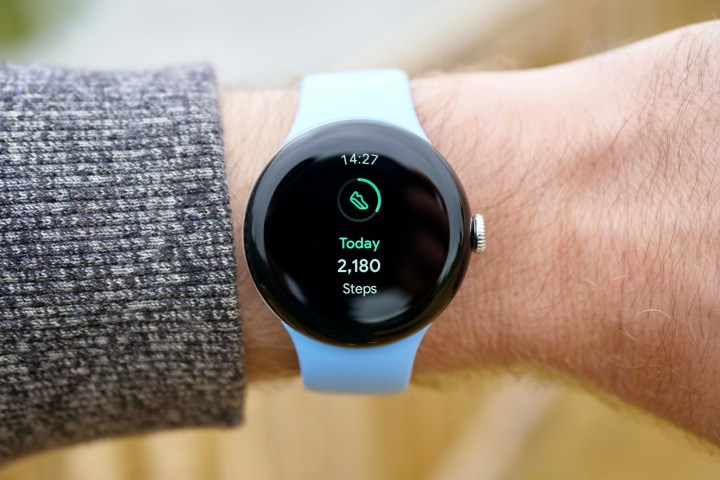
The Google Pixel Watch 2’s screen is a petite 1.2 inches with a 320 pixel-per-inch (ppi) pixel density and capable of a 1,000 nits maximum brightness. It’s smaller than the 40mm Samsung Galaxy Watch 6’s 1.3-inch screen and a lot smaller than the Mobvoi Ticwatch Pro 5’s 1.43-inch screen. It’s powered by the Qualcomm Snapdragon W5 processor (with an ARM Cortex M33 co-processor) and 2GB of RAM. This is a step up from the Exynos chip in the Pixel Watch and different from the Snapdragon W5+, which comes as a package with the ARM Cortex M55 co-processor in the Ticwatch Pro 5.
Performance is excellent. It’s smoother, less jittery, and more pleasant to use than the Pixel Watch. It’s not quite as fast as the Ticwatch Pro 5, but it doesn’t suffer from the occasional pauses or stutters that sometimes occur with the Galaxy Watch 6 and plagued the Pixel Watch. Even notoriously slow, energy-intensive apps like Google Maps are up and running in moments, and Tiles load their information immediately.
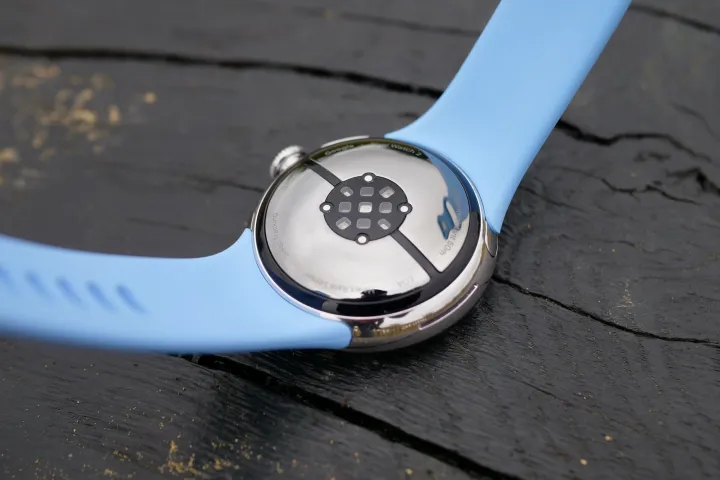
The screen is bright, but it’s too small to really capture color or to look visually interesting, and once again, a distractingly large bezel surrounds it. The screens on Samsung’s smartwatches are far more appealing. It’s also not always quick to react when waking up, but after this, I have not seen any issues with performance. The crown twists to move through menus and subtle haptics accompany it and other actions. There is a button to show recent apps, but it’s flush and hidden on the lower half of the case, making it awkward to locate and press.
On the back of the Google Pixel Watch 2 is an updated, more accurate multi-path optical heart rate sensor which also tracks blood oxygen levels, skin temperature, and stress. The Pixel Watch 2 will also take an electrocardiogram (ECG) reading and send notifications if it detects irregular heart rhythms. There’s also a compass, altimeter, gyroscope, accelerometer, barometer, and magnetometer.
Google Pixel Watch 2: Fitbit
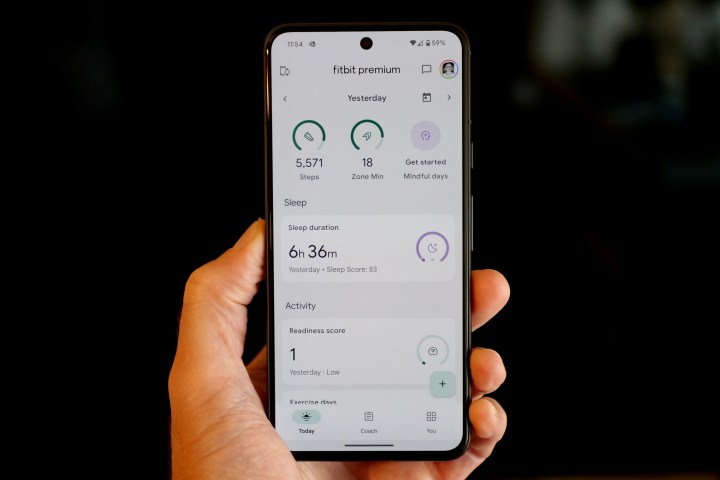
Fitbit is the Pixel Watch 2’s fitness platform. There’s a free version for everyone to use, or to access some features (including your Daily Readiness Score and in-depth sleep analysis), you’ll have to pay for Fitbit Premium. You get six months free with the Pixel Watch 2, and it’s $10 per month afterward. It’s not essential to anyone only casually interested in their health and fitness, but it’s an unpleasant addition to a $350 product, just as it is on the Oura Ring. Samsung Health and Garmin Health are not all that different functionally, yet both provide all data for free.
The further problem is the Fitbit platform is available on much cheaper products than the Pixel Watch 2, so if that’s the reason you’re thinking of buying it, why not spend half the price on a Fitbit Charge 6, which also comes with six months of free Fitbit Premium? It’s not like you’re really missing out on a stunning design by not going for the Pixel Watch 2. But before you get the Charge 6 instead, should you rush to get on board with Fitbit in the first place?
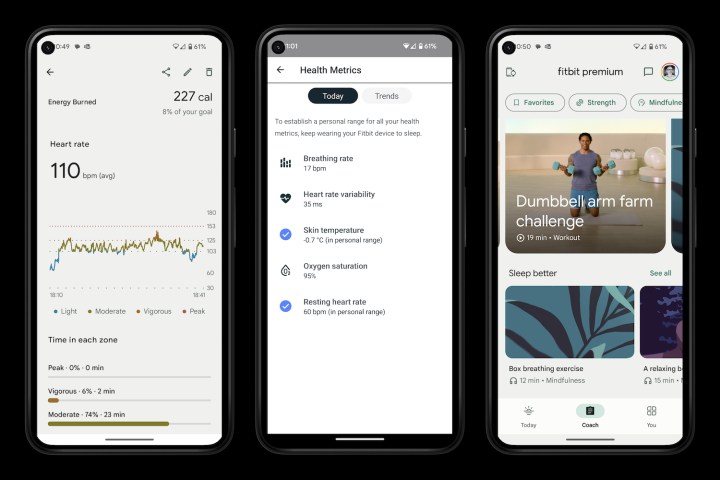
Don’t expect it to do anything hugely different from any other fitness platform. It tracks your workouts, sleep, steps, heart rate, and other metrics — just like most of its competitors. The newly redesigned Fitbit app is much easier to understand and navigate than before, with good use of white space and prioritization of sleep data — so essential to understanding your daily readiness and health. Individual sections are clearly separated, text is glanceable, and you can tap to see more in-depth data.
One new feature is stress management. Turn it on, and if the Pixel Watch 2 notices changes in your body, it prompts you to log your mood. It then proves a daily stress score, and it’s interesting to look at how your mood and stress correlate with each other and how movement and sleep influence it. It sends quite a few notifications though, so be prepared to interact with it often. This is also the case for the daily movement reminders. It sets a target of 250 steps per hour, and it does not let you forget.
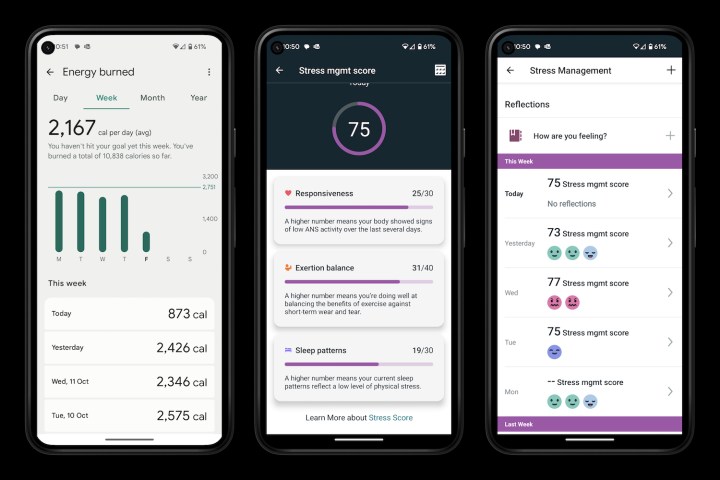
Automatic workout tracking kicks in about 10 minutes into one of the exercises it recognizes, or manually setting workout tracking in motion is quick and easy from a Tile or the Fitbit Exercise app, and there’s plenty of data shown on the watch’s screen when you’re exercising. One new feature is the ability to set your own heart rate zone, and the app will alert you when you reach it or push you harder to achieve it. Daily Readiness is another new metric, but it has not worked for me yet, with the number remaining unchanged.
The different workout controls are logically placed on the screen during a workout, and there’s no irritating voice coach shouting out your stats to the world (take note, Apple and Huawei). Dig deeper into the Fitbit app, and it begins to rely more on you being a Premium member, including accessing the coaching programs. Plus, all of Fitbit’s Safety Signal emergency features — including fall detection and Safety Check — require both the LTE Pixel Watch 2 and a Premium account.

Sleep tracking is another feature that shows more data when you have a premium subscription. The breakdown of data is impressive, with graphs on time asleep, REM and deep sleep stages, heart rate, and restorative time. Wear the Pixel Watch 2 for 14 days or more, and you get a full Sleep Profile. Data is also shown historically and includes hours slept and a look at your sleep schedule. It’s in-depth and informative, but the results do differ from my Oura Ring, mostly around time spent in different stages of sleep and the way both count time awake.
The Fitbit platform is expansive, detailed, and informative, yet still accessible to everyone regardless of fitness level or commitment. The new app has a great design too. However, the monthly subscription is a downside, and you can find other wearables with equal functionality and attractive apps — Samsung and Garmin, to name just two — that do not cost extra on top of the device.
Google Pixel Watch 2: Wear OS 4
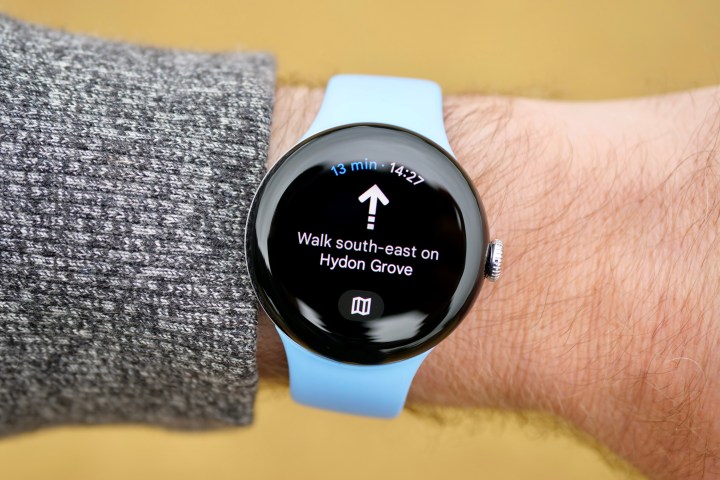
Google’s Wear OS 4 is installed on the Pixel Watch 2 and isn’t all that different from Wear OS 3.5. It still relies on the easy, convenient system of gestures to move around: sideways swipes to see Tiles — steps, weather, calendar, heart rate, and so on — an upward swipe to see your notifications, and down to see quick settings. Google’s promised efficiency improvements, along with the processor change, have made a positive difference to the Pixel Watch 2’s battery life. The small screen does make interacting with Wear OS feel like an oddly dainty exercise, though.
I’m disappointed with Wear OS’s reliability, something that doesn’t only affect the Pixel Watch, as the Galaxy Watch 6 Classic wasn’t much better. It doesn’t reliably deliver notifications from my phone — I’ve been using it connected to the Google Pixel 8 — and it has missed almost every phone call I’ve received too. It’s very frustrating to see a notification arrive on my phone’s lock screen and for the Pixel Watch 2 to sit there, not telling me anything. That’s fine when I’m at my desk, but not when I’m out, and my phone is in a bag. It has also randomly restarted after vibrating for a moment a few times.
Google’s efficiency improvements have made a positive difference to the Pixel Watch 2’s battery life.
Google Assistant is available either with a voice command or by long pressing the side button, and it has worked well. But Assistant’s reliability varies over time and between devices (my Google Pixel Tablet is going through a hard-of-hearing phase, for example), so I’m always half-waiting for it to stop working. When I reviewed the Apple Watch Series 9 recently, I was surprised at how much faster and better at understanding commands Siri had become, but I can’t say Assistant is noticeably better than it was on the Pixel Watch.
Several new apps have been released for Wear OS, and I’ve been using WhatsApp and Gmail on the Pixel Watch 2. Both look excellent, with designs that tie in with the phone apps, making using them very easy. Typing messages or replies on Wear OS’s keyboard is surprisingly natural, and it seems to be very accurate, but speech is the way to go for both. The microphone picked up my voice outside without issue, and I rarely had any awful inaccuracies to amend. Both are examples of how all apps should be on Wear OS going forward
Wear OS is far better than it used to be, and I’m very happy the era of Wear OS 2 appearing on every smartwatch has passed. But many of the issues that plagued the older versions remain, and while the design, functionality, app compatibility, and ease of use have improved, it’s still not quite as reliable and bug-free as it should be.
Google Pixel Watch 2: battery and charging
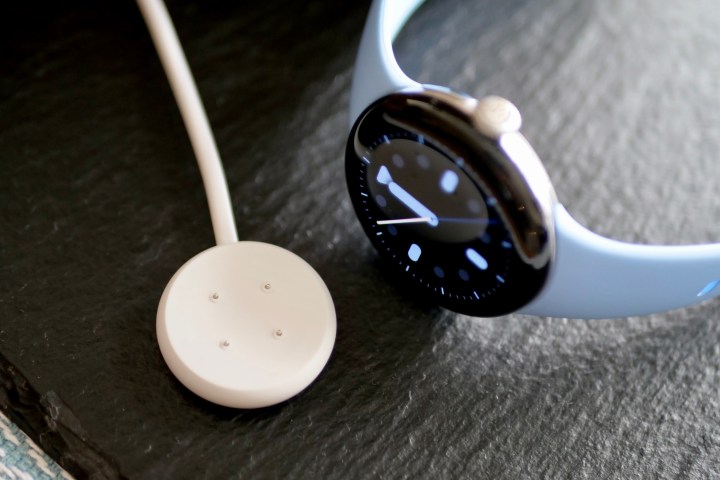
I’m a bit confused by the Google Pixel Watch 2’s battery and charging because it doesn’t seem to match what Google says about it. Google’s blurb says to expect 24 hours with the always-on display active and 100% battery charge in 75 minutes. I’m not getting either of those two figures, and normally this would make me pretty mad, but with the Pixel Watch 2, I’m seeing much better results from both.
I’ve used the Pixel Watch 2 with the always-on screen active, and since I started wearing it, the 306mAh battery has lasted for 24 hours minimum, with the maximum I’ve seen reaching almost 36 hours. This includes at least one 30-minute workout tracked with or without GPS and overnight sleep tracking. This is great and a huge improvement over the Pixel Watch’s woeful battery life. The Pixel Watch 2 comes with a proprietary charging puck, and after 30 minutes, the battery goes from almost flat to 70% and on to full in about 55 minutes.
The Pixel Watch 2 is usable all day, every day, and for any task.
I have noticed the battery charge indicator will stick at 98%, but when you take it off and put it back on the charger, it almost immediately reaches 100%. Perhaps it’s a software bug that will be fixed in the future. Here’s more on how various tasks affect the battery life: track sleep, and it’ll consume around 12%, while a single, 30-minute, non-GPS workout takes just 2%. Use Google Maps for navigation, and a 30-minute route takes about 7%. What this means is the Pixel Watch 2 is usable all day, every day, and for any task.
Google has redesigned the charging puck for the Pixel Watch 2, so you can’t use the one that came with the Pixel Watch. It uses a USB-C connection and has four quite sharp locating pins on the puck itself, which then magnetically fixes to the back of the Pixel Watch 2. It’s secure — more so than the Pixel Watch’s charger — but the puck itself feels cheap and nowhere near as high quality as the Apple Watch Series 9 or Samsung Galaxy Watch 6 Classic’s charger.
Google Pixel Watch 2: price and availability
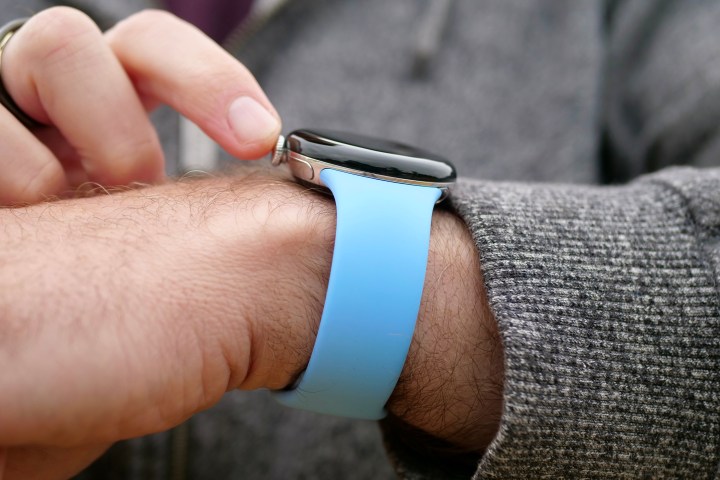
There are two versions of the Google Pixel Watch 2. The cheapest is the Wi-Fi model at $349, while the model with an LTE connection will cost you $399. Remember, if you want to make use of the LTE connection, you will have to pay an additional charge to your carrier, which is usually around $10 per month. In the U.K., the Pixel Watch 2 costs 349 British pounds for the Wi-Fi model or 399 pounds for the LTE model.
You’ve got the choice of four different color combinations, but sadly you can’t mix and match like you can with the Apple Watch Series 9. The Polished Silver case with a Bay Active Band is the one featured in our photos, or you can pick a Matte Black with the Obsidian Active Band, a Champagne Gold with the Hazel Active Band, or a Polished Silver with the Porcelain Active Band. As discussed above, the Pixel Watch 2 only comes in a single 41mm case size.
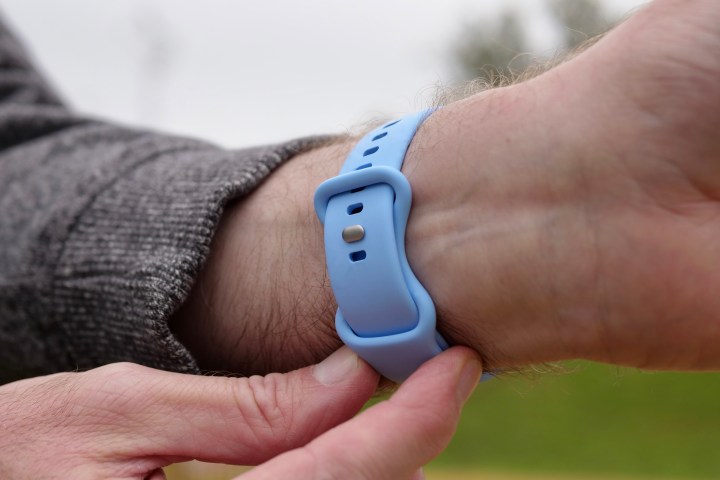
The Google Pixel Watch 2 is quite expensive compared with the Samsung Galaxy Watch 6, which starts at $299 but is similar to the Galaxy Watch 6 Classic, which starts at $399. Samsung often has good offers available, too, potentially reducing the price further. The Mobvoi Ticwatch Pro 5 starts at $350. These are the most obvious competitors, but there are some other choices to think hard about too.
I really like the Garmin Vivomove Trend, which expertly bridges in-depth fitness tracking and lifestyle-friendly design, and costs $299. If you’re sold on Fitbit’s platform, the new Fitbit Charge 6 costs $160, and the Fitbit Sense 2 costs $300. Neither quite match the Pixel Watch 2’s feature list, but they aren’t all that different, and you avoid Wear OS’s downsides at the same time. It’s worth taking a look at all three, as you could end up saving quite a lot of money (and annoyance) by foregoing Pixel Watch features you won’t need.
Google Pixel Watch 2: verdict
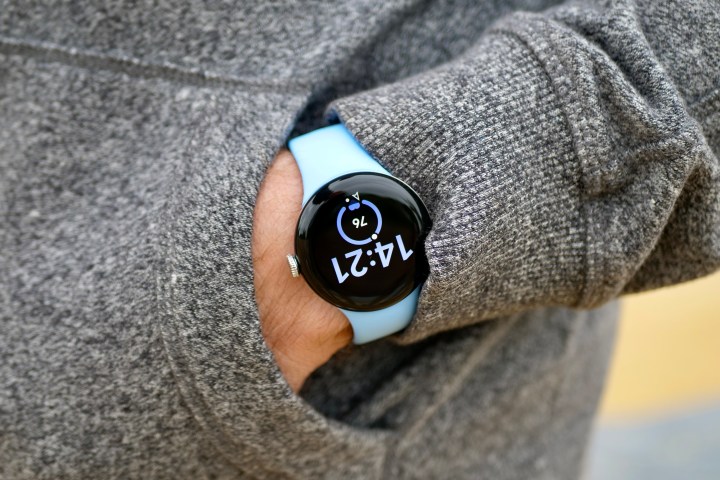
The Pixel Watch 2 is far better than the Pixel Watch. The battery lasts longer, it’s faster, and interacting with it feels altogether slicker. It’s even more comfortable to wear, and the reduction in weight has made a real difference, ensuring you can make the most out of its comprehensive health and fitness tracking.
But for all these improvements, other problems have been carried over. There’s still only one case size, the design is underwhelming, the screen’s bezel is too big, it doesn’t feel especially expensive, and Wear OS isn’t as reliable as it should be. Fitbit’s redesign has improved the app, but hiding features behind a subscription isn’t welcome at all.
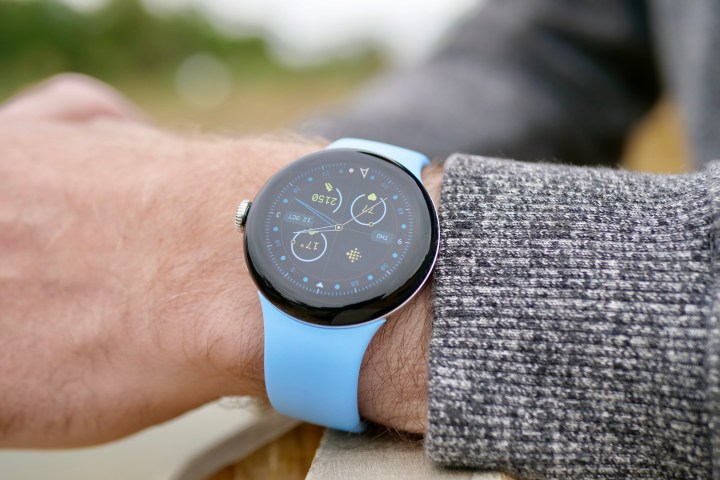
Much as I like the Bay Blue band, the rest of the Pixel Watch 2’s design leaves me cold, and because it’s functionally no better than the beautiful Galaxy Watch 6 Classic, I’d much rather wear that. If I didn’t care about design at all or wanted to hide my fitness wearable while I wore a traditional watch, I’d buy the Fitbit Charge 6 or a similar fitness tracker instead.
All this said, it’s great to see the Pixel Watch’s technical shortcomings rectified with the Pixel Watch 2. It means it’s actually a recommended buy this time around, but only if you can get past the painfully ordinary design, are sure the case size suits your wrist, and don’t mind paying monthly for all Fitbit’s data. Those are a lot of ifs, but if you don’t mind them, the Google Pixel Watch 2 is worth your attention.

